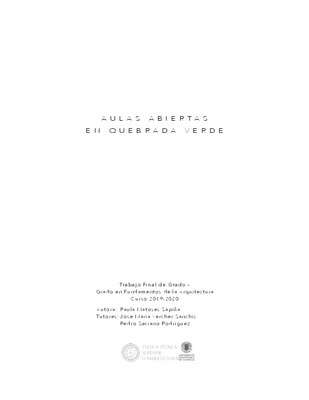JavaScript is disabled for your browser. Some features of this site may not work without it.
Buscar en RiuNet
Listar
Mi cuenta
Estadísticas
Ayuda RiuNet
Admin. UPV
Aulas abiertas en Quebrada Verde
Mostrar el registro sencillo del ítem
Ficheros en el ítem
| dc.contributor.advisor | Vercher Sanchis, José María
|
es_ES |
| dc.contributor.advisor | Serrano Rodriguez, Pedro
|
es_ES |
| dc.contributor.author | Matoses Sapiña, Paula
|
es_ES |
| dc.coverage.spatial | east=-71.65606869999999; north=-33.1081063; name=Província de Valparaíso, Valparaíso, Xile | es_ES |
| dc.date.accessioned | 2020-01-24T08:44:22Z | |
| dc.date.available | 2020-01-24T08:44:22Z | |
| dc.date.created | 2019-10-24 | |
| dc.date.issued | 2020-01-24 | es_ES |
| dc.identifier.uri | http://hdl.handle.net/10251/135463 | |
| dc.description.abstract | [ES] Aquest treball pretén fer visible com una arquitectura és sostenible en tant i com s¿adapei als recursos que disposa i a les tradicions de la gent que l¿habita. I com l¿arquitec- tura vernacla era un clar exemple de sostenibilitat per la seua lògica i coherència constructiva. Mitjançant l¿encàrrec d¿un projecte que ha de ser de baix cost, flexible i amb recursos naturals, recurrim a tècniques d¿abans, pròpies de l¿emplaçament per aconseguir una ar- quitectura respectuosa amb el medi, que s¿adapte a l¿en- tron i siga acceptada per la societat, i la sentisquen seua, fent-los partícips. D¿aquesta manera, es vol demostrar que podem extreure coneixements de tècniques antigues per construir arqui- tectura contemporània i els avantatges que comporta. | es_ES |
| dc.description.abstract | [EN] This work aims to make visible how an architecture is sus- tainable as long as it adapts to the resources it has, and the traditions of the people who inhabit it. And as ver- nacular architecture was a clear example of sustainability because of its logic and constructive coherence. Through the assigment of a project that must be low-cost, flexible and with natural resources, we resort to techni- ques of yesteryear, typical of the site, in order to achieve an eco-friendly architecture that adapts to the environ- ment and it was accepted by the society, and make them feel it is from their, making them participants. In this way, we want to demonstrate that we can extract knowledge of ancient techniques to build contemporary architecture and the advantages that it entails. | es_ES |
| dc.language | Español | es_ES |
| dc.publisher | Universitat Politècnica de València | es_ES |
| dc.rights | Reconocimiento (by) | es_ES |
| dc.subject | Sostenibilidad | es_ES |
| dc.subject | Entorno | es_ES |
| dc.subject | Participación | es_ES |
| dc.subject | Bioconstrucción | es_ES |
| dc.subject | Tradición. | es_ES |
| dc.subject | Sustainability | es_ES |
| dc.subject | Surroundings | es_ES |
| dc.subject | Participation | es_ES |
| dc.subject | Bioconstruction | es_ES |
| dc.subject | Tradition. | es_ES |
| dc.subject.classification | CONSTRUCCIONES ARQUITECTONICAS | es_ES |
| dc.subject.other | Grado en Fundamentos de la Arquitectura-Grau en Fonaments de l'Arquitectura | es_ES |
| dc.title | Aulas abiertas en Quebrada Verde | es_ES |
| dc.type | Proyecto/Trabajo fin de carrera/grado | es_ES |
| dc.rights.accessRights | Abierto | es_ES |
| dc.description.bibliographicCitation | Matoses Sapiña, P. (2019). Aulas abiertas en Quebrada Verde. http://hdl.handle.net/10251/135463 | es_ES |
| dc.description.accrualMethod | TFGM | es_ES |
| dc.relation.pasarela | TFGM\112371 | es_ES |
Este ítem aparece en la(s) siguiente(s) colección(ones)
-
ETSA - Trabajos académicos [4687]
Escuela Técnica Superior de Arquitectura






